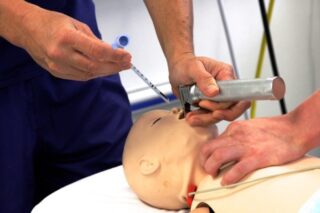Q Exchange
Critical Incident Simulation Team Training for areas delivering anaesthetic care.
- Idea
- 2018

Meet the team: #MITS Multidisciplinary Insitu Theatre Simulation
Also:
- Andrew Vaughton - consultant anaesthetist
- Lynsey Woodward - consultant anaesthetist
The challenge:
Regular theatre simulation training has been embedded in our organisation to expose theatre staff to infrequent procedures and adverse surgical/anaesthetic incidents. However, a number of stakeholders and areas are not currently involved in the training. There is an opportunity to expand in-situ simulation training tailored to different areas delivering anaesthetic care across the hospital site.
Background evidence
Evidence shows that in-situ simulation in healthcare is cost effective, educationally efficient, improves team morale and is valuable to test real healthcare systems. It is potentially visible to the public, increasing public confidence in our health care service.
We provide monthly scenario based training on anaesthetic emergencies to our theatre staff. Staff are expected to react in real time and use all necessary resources at their disposal. Debrief sessions allow for learning and reflection from all staff on any problems encountered. Feedback from staff has been extremely positive. Overall 96% felt the simulation was relevant to their role. 90% felt more confident about managing emergencies as a team and 93% were more aware of how to deal with these emergencies in theatre. To date, in situ training has brought about a number of changes in practice including introduction of emergency protocols for emergency aneurysms, poster guidance for difficult airways and recommendations on which staff to contact and when.
The multi-disciplinary response to emergency scenarios in theatre needs to be rapid, fluid and efficient. In situ simulation training provides a unique opportunity to practice this as a team, to test established processes and highlight environmental factors prior to a real emergency. Embedding this training into routine practice furthers education, improves theatre staff confidence and ultimately enhances patient safety by increasing confidence and experience in managing critical incidents
Our proposal
To deliver fortnightly multidisciplinary simulator training to include all stakeholders involved in anaesthetic care throughout our hospital. The in-situ training allows training of care providers as a team in their normal working environment. The emphasis is on human factors, non-technical skills and team work. We have developed the scenarios to reflect real incidents to allow teams to come together and practice in a non-threatening, safe environment.
We have already witnessed the benefits of embedding team training into our main theatres, however there are an increasing number of distant sites that would also benefit from this type of training. The challenge to expanding further has always been down to time and faculty. Our care group managers fully support the expansion of the training and we have a number of senior health care professionals who are committed and trained in simulator training to deliver the training.
The funding would allow us to expand the faculty and re-allocate time within the working day to deliver training. We would anticipate other costs in developing the training material and putting together a curriculum that we would expect staff to attain over a designated period of time.
Benefits
-
Our goal is to expand and embed training to include all stakeholders (theatre staff, surgeons, anaesthetists, interventional radiology, interventional cardiology and endoscopy staff) involved in delivering anaesthetic care to patients. We envisage the in situ simulator sessions becoming an integral part of everyone’s training. This will have a significant impact on improving teamwork, morale and patient safety and deliver NATSIPs requirement for multidisciplinary training.
-
For outcome measures we will continue to collect staff feedback by pre-session and post-training questionnaires, develop a curriculum of staff training in emergency scenarios and equipment, survey staff satisfaction and look at rates of reported critical incidents in the trust.
Benefits for the Q community
To develop an integrated multidisciplinary training program that involves all stakeholders and can be applied by other NHS providers. We will share our learning with the Q community by offering webinars and by developing our faculty within the Wessex region.
How you can contribute
- feedback
- expert advice
Comments
Thomas John Rose 19 Jun 2018
Sorry that I've not commented on this idea previously. Not sure about expert advice but I can provide some feedback. All training is a good thing and the additional training that you are proposing is particularly good. I would be very happy to produce some flow charts to support your simulations if you think that this would benefit your learners. I'd be interested to see the curriculum when it is finished. Multidisciplinary training will, I'm sure, be good for the learners. Maybe if you video the simulation and play it back at the end of the session it would extend the learning - or do you already do that? Tom
Comments are now closed for this post.